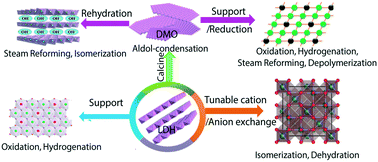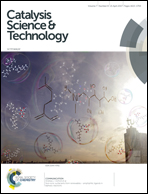Catalytic application of layered double hydroxide-derived catalysts for the conversion of biomass-derived molecules
Abstract
Layered double hydroxides (LDH) consist of positively-charged metal hydroxide layers and negatively-charged anions and water in the interstitial layers. Due to the unique properties of LDH including (i) tunable basicity, (ii) tailorable acidity, (iii) cation-exchange ability of the Brucite-like layer, (iv) anion-exchange ability of the interlayer space, (v) thermal stability, and (vi) large adsorption capacity, LDH-based materials could offer significant breadth for the conversion of biomass, either directly as catalysts or active supports in multifunctional catalysts. This review specially concentrates on the relationship between properties and their performances in the transformation (e.g. oxidation, hydrogenation, dehydration, isomerization, steam reforming and so on) of biomass-derived model molecules. This review demonstrates that LDH and their derived metal oxides (DMO) can be successfully applied over a broad spectrum for the conversion of biomass with advantages such as improved activity, selectivity, and metal dispersion, less waste production, and an improved recuperation of immobilized catalysts. LDH and their DMO are also excellent materials for designing bifunctional redox-base catalysts or controlling the acid–base properties around a heterogenized metal center.

- This article is part of the themed collection: 2017 Catalysis Science & Technology HOT Articles


 Please wait while we load your content...
Please wait while we load your content...